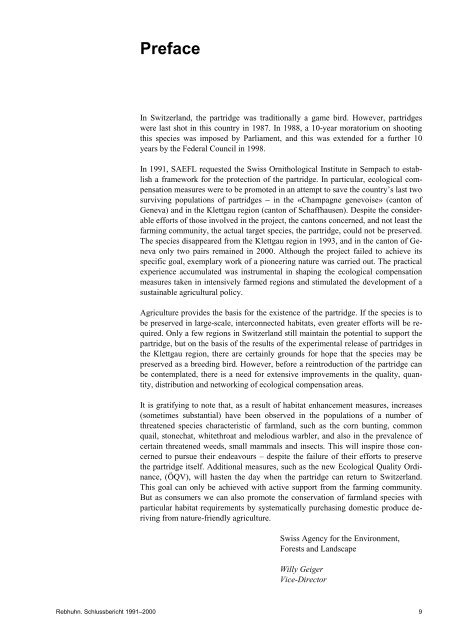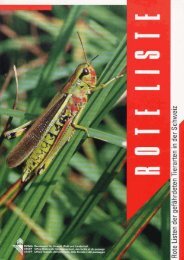Rebhuhn. Schlussbericht 1991–2000 - BAFU
Rebhuhn. Schlussbericht 1991–2000 - BAFU
Rebhuhn. Schlussbericht 1991–2000 - BAFU
Erfolgreiche ePaper selbst erstellen
Machen Sie aus Ihren PDF Publikationen ein blätterbares Flipbook mit unserer einzigartigen Google optimierten e-Paper Software.
Preface<br />
In Switzerland, the partridge was traditionally a game bird. However, partridges<br />
were last shot in this country in 1987. In 1988, a 10-year moratorium on shooting<br />
this species was imposed by Parliament, and this was extended for a further 10<br />
years by the Federal Council in 1998.<br />
In 1991, SAEFL requested the Swiss Ornithological Institute in Sempach to establish<br />
a framework for the protection of the partridge. In particular, ecological compensation<br />
measures were to be promoted in an attempt to save the country’s last two<br />
surviving populations of partridges − in the «Champagne genevoise» (canton of<br />
Geneva) and in the Klettgau region (canton of Schaffhausen). Despite the considerable<br />
efforts of those involved in the project, the cantons concerned, and not least the<br />
farming community, the actual target species, the partridge, could not be preserved.<br />
The species disappeared from the Klettgau region in 1993, and in the canton of Geneva<br />
only two pairs remained in 2000. Although the project failed to achieve its<br />
specific goal, exemplary work of a pioneering nature was carried out. The practical<br />
experience accumulated was instrumental in shaping the ecological compensation<br />
measures taken in intensively farmed regions and stimulated the development of a<br />
sustainable agricultural policy.<br />
Agriculture provides the basis for the existence of the partridge. If the species is to<br />
be preserved in large-scale, interconnected habitats, even greater efforts will be required.<br />
Only a few regions in Switzerland still maintain the potential to support the<br />
partridge, but on the basis of the results of the experimental release of partridges in<br />
the Klettgau region, there are certainly grounds for hope that the species may be<br />
preserved as a breeding bird. However, before a reintroduction of the partridge can<br />
be contemplated, there is a need for extensive improvements in the quality, quantity,<br />
distribution and networking of ecological compensation areas.<br />
It is gratifying to note that, as a result of habitat enhancement measures, increases<br />
(sometimes substantial) have been observed in the populations of a number of<br />
threatened species characteristic of farmland, such as the corn bunting, common<br />
quail, stonechat, whitethroat and melodious warbler, and also in the prevalence of<br />
certain threatened weeds, small mammals and insects. This will inspire those concerned<br />
to pursue their endeavours – despite the failure of their efforts to preserve<br />
the partridge itself. Additional measures, such as the new Ecological Quality Ordinance,<br />
(ÖQV), will hasten the day when the partridge can return to Switzerland.<br />
This goal can only be achieved with active support from the farming community.<br />
But as consumers we can also promote the conservation of farmland species with<br />
particular habitat requirements by systematically purchasing domestic produce deriving<br />
from nature-friendly agriculture.<br />
Swiss Agency for the Environment,<br />
Forests and Landscape<br />
Willy Geiger<br />
Vice-Director<br />
<strong>Rebhuhn</strong>. <strong>Schlussbericht</strong> <strong>1991–2000</strong> 9



